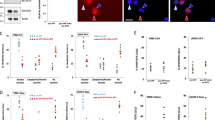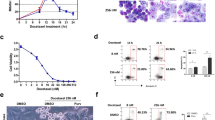Abstract
Increased survivin expression is a negative prognostic marker in many tumours, including ovarian cancer. We show here that ovarian carcinoma cells upregulate survivin transcription in response to increased expression of the proapoptotic protein procaspase 3. We have utilized this observation in a combination gene therapy strategy using adenoviral constructs expressing the dominant-negative mutant survivin T34A (Ad Survivin T34A) and procaspase 3 (Ad Caspase 3) in ovarian carcinoma cell lines. Transfection of ovarian carcinoma cells with Ad Survivin T34A induces apoptosis via a caspase 9-mediated pathway that is not affected by cell cycle block prior to G2/M. Ad Survivin T34A-induced apoptosis can be significantly enhanced by cotransfection with Ad Caspase 3, and the combination of Ad Survivin T34A and Ad Caspase 3 leads to a significant increase in survival in a murine intraperitoneal ovarian carcinoma model with some long-term survivors. This suggests that inhibiting endogenous survivin activity while also delivering high levels of procaspase 3 allow proteolytic cleavage and activation of the terminal caspase cascade leading to tumour cell death.
This is a preview of subscription content, access via your institution
Access options
Subscribe to this journal
Receive 50 print issues and online access
$259.00 per year
only $5.18 per issue
Buy this article
- Purchase on Springer Link
- Instant access to full article PDF
Prices may be subject to local taxes which are calculated during checkout





Similar content being viewed by others
References
Adams RR, Carmena M and Earnshaw WC . (2001). Trends Cell Biol., 11, 49–54.
Ambrosini G, Adida C, Sirugo G and Altieri DC . (1998). J. Biol. Chem., 273, 11177–111782.
Asanuma K, Moriai R, Yajima T, Yagihashi A, Yamada M, Kobayashi D and Watanabe N . (2000). Jpn. J. Cancer Res., 91, 1204–1209.
Banks DP, Plescia J, Altieri DC, Chen J, Rosenberg SH, Zhang H and Ng SC . (2000). Blood, 96, 4002–4003.
Blanc-Brude OP, Yu J, Simosa H, Conte MS, Sessa WC and Altieri DC . (2002). Nat. Med., 8, 987–994.
Bratton SB, Walker G, Srinivasula SM, Sun XM, Butterworth M, Alnemri ES and Cohen GM . (2001). EMBO J., 20, 998–1009.
Chai J, Du C, Wu JW, Kyin S, Wang X and Shi Y . (2000). Nature, 406, 855–862.
Chen J, Wu W, Tahir SK, Kroeger PE, Rosenberg SH, Cowsert LM, Bennett F, Krajewski S, Krajewska M, Welsh K, Reed JC and Ng SC . (2000). Neoplasia, 2, 235–241.
Conway EM, Pollefeyt S, Cornelissen J, DeBaere I, Steiner-Mosonyi M, Ong K, Baens M, Collen D and Schuh AC . (2000). Blood, 95, 1435–1442.
Deveraux QL, Takahashi R, Salvesen GS and Reed JC . (1997). Nature, 388, 300–304.
Dong Z, Nishiyama J, Yi XL, Venkatachalam MA, Denton M, Gu SM, Li SL and Qiang M . (2002). Biochem. J., 364, 413–421.
Du C, Fang M, Li Y, Li L and Wang X . (2000). Cell, 102, 33–42.
Grossman D, Kim PJ, Schechner JS and Altieri DC . (2001). Proc. Natl. Acad. Sci. USA, 98, 635–640.
He TC, Zhou S, da Costa LT, Yu J, Kinzler KW and Vogelstein B . (1998). Proc. Natl. Acad. Sci. USA, 95, 2509–2514.
Ikeguchi M, Nakamura S and Kaibara N . (2002). Oncol. Rep., 9, 1121–1126.
Kovarik A, Peat N, Wilson D, Gendler S and Taylor-Papadimitriou J . (1993). J. Biol. Chem., 268, 9917–9926.
Lavoie JN, Nguyen M, Marcellus RC, Branton PE and Shore GC . (1998). J. Cell Biol., 140, 637–645.
Li F, Ackermann EJ, Bennett CF, Rothermel AL, Plescia J, Tognin S, Villa A, Marchisio PC and Altieri DC . (1999). Nat. Cell Biol., 1, 461–466.
Li F, Ambrosini G, Chu EY, Plescia J, Tognin S, Marchisio PC and Altieri DC . (1998). Nature, 396, 580–584.
Liston P, Roy N, Tamai K, Lefebvre C, Baird S, Cherton-Horvat G, Farahani R, McLean M, Ikeda JE, MacKenzie A and Korneluk RG . (1996). Nature, 379, 349–353.
Livne A, Shtrichman R and Kleinberger T . (2001). J. Virol., 75, 789–798.
McNeish IA, Tenev T, Bell S, Marani M, Vassaux G and Lemoine N . (2001). Cancer Gene Ther., 8, 308–319.
Mesri M, Wall NR, Li J, Kim RW and Altieri DC . (2001). J. Clin. Invest., 108, 981–990.
Nicholson D . (1999). Cell Death Differ., 6, 1028–1042.
O'Connor DS, Grossman D, Plescia J, Li F, Zhang H, Villa A, Tognin S, Marchisio PC and Altieri DC . (2000). Proc. Natl. Acad. Sci. USA, 97, 13103–13107.
Sarela AI, Macadam RC, Farmery SM, Markham AF and Guillou PJ . (2000). Gut, 46, 645–650.
Shariat SF, Desai S, Song W, Khan T, Zhao J, Nguyen C, Foster BA, Greenberg N, Spencer DM and Slawin KM . (2001). Cancer Res., 61, 2562–2571.
Shin S, Sung BJ, Cho YS, Kim HJ, Ha NC, Hwang JI, Chung CW, Jung YK and Oh BH . (2001). Biochemistry, 40, 1117–1123.
Shinoura N, Muramatsu Y, Yoshida Y, Asai A, Kirino T and Hamada H . (2000). Exp. Cell Res., 256, 423–433.
Silke J, Ekert PG, Day CL, Hawkins CJ, Baca M, Chew J, Pakusch M, Verhagen AM and Vaux DL . (2001). EMBO J., 20, 3114–3123.
Silke J and Vaux DL . (2001). J. Cell Sci., 114, 1821–1827.
Skoufias DA, Mollinari C, Lacroix FB and Margolis RL . (2000). J. Cell Biol., 151, 1575–1582.
Speliotes EK, Uren A, Vaux D and Horvitz HR . (2000). Mol. Cell, 6, 211–223.
Suzuki A, Hayashida M, Ito T, Kawano H, Nakano T, Miura M, Akahane K and Shiraki K . (2000). Oncogene, 19, 3225–3234.
Takahashi R, Deveraux Q, Tamm I., Welsh K, Assa-Munt N, Salvesen GS and Reed JC . (1998). J. Biol. Chem., 273, 7787–7790.
Tamm I, Wang Y, Sausville E, Scudiero DA, Vigna N, Oltersdorf T and Reed JC . (1998). Cancer Res., 58, 5315–5320.
Tenev T, Marani M, McNeish I and Lemoine NR . (2001). Cell Death Differ., 8, 256–264.
Uren AG, Wong L, Pakusch M, Fowler KJ, Burrows FJ, Vaux DL and Choo KH . (2000). Curr. Biol., 10, 1319–1328.
Vasquez RJ, Howell B, Yvon AM, Wadsworth P and Cassimeris L . (1997). Mol. Biol. Cell, 8, 973–985.
Verdecia MA, Huang H, Dutil E, Kaiser DA, Hunter T and Noel JP . (2000). Nat. Struct. Biol., 7, 602–608.
Verhagen AM, Ekert PG, Pakusch M, Silke J, Connolly LM, Reid GE, Moritz RL, Simpson RJ and Vaux DL . (2000). Cell, 102, 43–53.
Wall NR, O'Connor DS, Plescia J, Pommier Y and Altieri DC . (2003). Cancer Res., 63, 230–235.
Yamabe K, Shimizu S, Ito T, Yoshioka Y, Nomura M, Narita M, Saito I, Kanegae Y and Matsuda H . (1999). Gene Therapy., 6, 1952–1959.
Yoshida H, Ishiko O, Sumi T, Matsumoto Y and Ogita S . (2001). Int. J. Oncol., 19, 537–542.
Zhao J, Tenev T, Martins LM, Downward J and Lemoine NR . (2000). J. Cell Sci., 113, 4363–4371.
Zou H, Li Y, Liu X and Wang X . (1999). J. Biol. Chem., 274, 11549–11556.
Author information
Authors and Affiliations
Corresponding author
Rights and permissions
About this article
Cite this article
McKay, T., Bell, S., Tenev, T. et al. Procaspase 3 expression in ovarian carcinoma cells increases survivin transcription which can be countered with a dominant-negative mutant, survivin T34A; a combination gene therapy strategy. Oncogene 22, 3539–3547 (2003). https://doi.org/10.1038/sj.onc.1206417
Received:
Revised:
Accepted:
Published:
Issue Date:
DOI: https://doi.org/10.1038/sj.onc.1206417
Keywords
This article is cited by
-
14-Deoxy-11,12-didehydroandrographolide inhibits proliferation and induces GSH-dependent cell death of human promonocytic leukemic cells
Journal of Natural Medicines (2014)
-
Enhancement of cisplatin sensitivity in lewis lung carcinoma by liposome-mediated delivery of a survivin mutant
Journal of Experimental & Clinical Cancer Research (2010)
-
The influence of survivin shRNA on the cell cycle and the invasion of SW480 cells of colorectal carcinoma
Journal of Experimental & Clinical Cancer Research (2008)
-
Kinetic analysis of the mechanism of plasminogen activation by streptokinase
Journal of Mathematical Chemistry (2007)
-
Survivin expression in “low-risk” and “high-risk” myelodysplastic syndromes
Annals of Hematology (2007)



